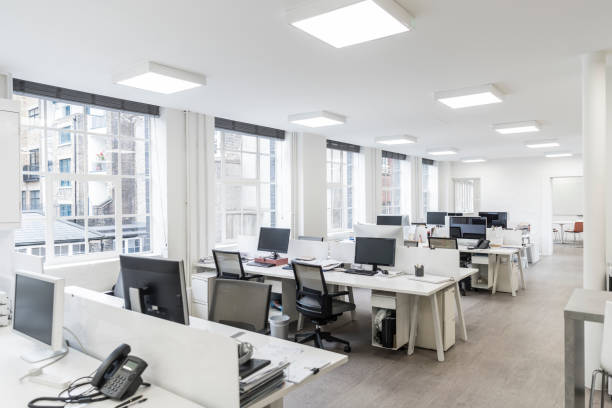In today’s fast-paced work environment, the right office furniture is not just a luxury; it’s a necessity for maintaining both productivity and well-being. Well-designed office workstations go beyond mere aesthetics and functionality—it plays a crucial role in enhancing comfort and reducing stress. Investing in the right office furniture can transform your workspace into a haven of comfort, productivity, and health.
The Impact of Ergonomics on Comfort
Ergonomics is the science of designing workspaces that fit the user’s needs, which significantly affects comfort and stress levels. An ergonomic office workstation is tailored to support the natural posture of the user, minimizing strain on the body. Key components of ergonomic design include adjustable chairs, desks, and monitor stands.
Adjustable Chairs
The centerpiece of any ergonomic workstation is the chair. An adjustable chair with proper lumbar support can make a world of difference. It should support the lower back, promote a neutral spine position, and allow adjustments in height and tilt. This adaptability helps to prevent common issues such as back pain, neck strain, and poor circulation, all of which can contribute to workplace stress.
Desks and Work Surfaces
Desks that accommodate various work styles are essential for reducing physical stress. Height-adjustable desks, for instance, allow users to alternate between sitting and standing, which can alleviate the discomfort associated with prolonged sitting. A well-designed desk should also have ample space for movement and organization, reducing the likelihood of clutter and promoting a more serene work environment.
Monitor Placement
Proper monitor placement is another critical factor. Monitors should be positioned at eye level to prevent neck strain and should be at least an arm’s length away to reduce eye fatigue. Adjustable monitor arms can help achieve the optimal viewing angle and distance, contributing to a more comfortable and stress-free work experience.
The Role of Lighting and Acoustics
While ergonomic furniture forms the foundation of a comfortable workstation, other environmental factors also play a significant role in reducing stress.
Lighting
Proper lighting is crucial for both comfort and productivity. Natural light is ideal, but when that’s not possible, adjustable task lighting can help reduce eye strain and improve focus. Lighting should be evenly distributed across the workspace, minimizing shadows and glare on screens.
Acoustics
Noise levels can significantly impact stress levels and concentration. Acoustic panels or noise-cancelling headphones can help mitigate distractions and create a more peaceful work environment. An office layout that includes quiet zones and spaces for collaboration can also balance productivity with comfort.
Personalization and Aesthetics
Personalizing your workstation can enhance comfort and reduce stress by creating a space that feels uniquely yours. Incorporating elements like plants, artwork, or personal mementos can make the workspace more inviting and less sterile. A well-decorated environment can boost morale and make the workday more enjoyable.
Plants and Greenery
Adding plants to your workstation has multiple benefits. Plants can improve air quality, reduce stress, and increase overall well-being. Studies have shown that having greenery in the office can lower blood pressure and enhance mood, making it a simple yet effective way to improve comfort.
Color and Design
The colors and design elements of your workstation can also affect your mood and stress levels. Calming colors like blues and greens can create a more relaxing atmosphere, while vibrant colors might boost energy and creativity. The design of your workspace should reflect your personal preferences and work style, contributing to a more pleasant work experience.
Technology and Innovation in Office Workstations
Advancements in technology continue to shape the future of office workstations. Innovations in furniture design and workplace technology can further enhance comfort and reduce stress.
Smart Furniture
Smart furniture integrates technology to provide additional features that improve comfort. For example, some desks come with built-in sensors that remind users to take breaks or adjust their posture. Ergonomic chairs might include heating and massage functions, providing added comfort during long work hours.
Integrated Cable Management
Tangled cables can create visual clutter and physical obstacles. Office furniture with integrated cable management systems helps keep wires organized and out of the way, reducing distractions and contributing to a cleaner, more streamlined workspace.
The Benefits of a Well-Designed Workstation
Investing in a well-designed office workstation has far-reaching benefits beyond just comfort. It can lead to improved productivity, reduced absenteeism, and a better overall work experience. When employees are comfortable and less stressed, they are more likely to be engaged and motivated, which ultimately benefits the entire organization.
Long-Term Health Benefits
The long-term health benefits of a comfortable workstation are significant. By reducing the risk of musculoskeletal disorders and other work-related ailments, a well-designed workstation promotes better health and reduces the likelihood of chronic conditions. This, in turn, leads to fewer sick days and a more resilient workforce.
Enhanced Job Satisfaction
Comfortable and well-designed workspaces contribute to higher job satisfaction. Employees who feel good in their work environment are more likely to enjoy their work and remain with their employer. This can lead to lower turnover rates and a more stable, experienced team.
In conclusion, creating an office workstation that enhances comfort and reduces stress involves a thoughtful combination of ergonomic design, environmental factors, personalization, and technological innovation. By prioritizing these elements, you can create a workspace that not only supports your well-being but also boosts productivity and job satisfaction. Investing in quality office furniture and a well-designed workspace is an investment in both individual health and organizational success.




